
Keen to start a small business but unsure what you should do?
You’re not alone. Every year thousands of people make the leap from working in a job to becoming entrepreneurs.
Sadly, many startups and Small and Medium Enterprises (SMEs) fail.
The number one reason for their demise? Choosing the wrong market!
But what steps should you take to choose the right market? And how can you reduce the risks involved in entrepreneurship?
Enter Choose — The Single Most Important Decision Before Starting Your Business by serial entrepreneur and investor Ryan Levesque. Covering the steps you need to take to improve your chances of startup success, it provides a useful guide to newbie entrepreneurs before they make the leap.
In this article, you will some of the useful techniques covered in the book, including…
- How to develop the right business model
- How to find opportunities that suit your entrepreneurial style
- How to zoom in on the right business idea
- What SEO keyword should you use
- How to find the right market based on size, competition, and customer
- How to launch your business
Let’s go!
#1 Brainstorming Your Business Idea
The first steps you need to take is to choose the right business model, potential market, and business idea.
a) The Right Business Model
According to Levesque, the best business models are those focusing on education and expertise. Such businesses (which includes mine, by the way), have lower development costs and can be launched quickly with low operating costs.
In thinking about your business model, consider the following product categories:
- Product Focused: Providing consistency, they include digital courses, eBooks (PDFs), and physical books
- Client Focused: Providing case studies, they include private consulting, masterminds, and group coaching
- Membership Focused: Providing continuity, they include membership sites and online communities
- Event Focused: Providing concentration, they include workshops, boot camps, and live events
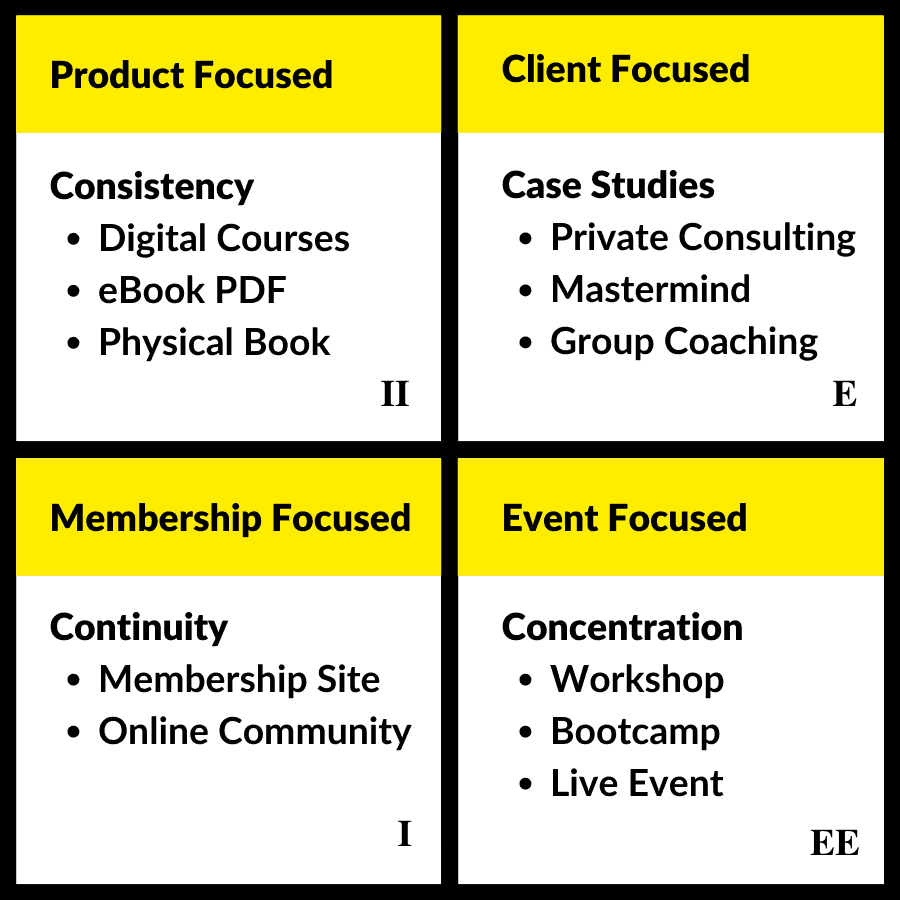
Courtesy of Charelle Griffith
You may also wish to incorporate the IN/UP/MAX concept in scaling up your business revenue:
- IN: This the low-priced product that you can offer 100 percent of your customers with a low barrier to entry. For example, it can be a $20 eBook or a $50 online course.
- UP: This is the moderate-priced product that is 10 times the cost of your IN product which you can offer 10 percent of your customers. For example, it can be a $200 short-course, or a $500 personal consultation.
- MAX: This is the premium-priced product 100 times the cost of your IN product which you offer 1 percent of your best customers. It can be a $2,000 consulting effort, or a $5,000 done-for-you project.
b) The Right Market Type
After you’ve considered the best business model to focus on, you’ll need to think about your entrepreneurial style.
According to Levesque, there are four main types of entrepreneurs:
- Mission Based: You have a clear and specific mission to pursue that you would “die on the hill” for, allowing you to make a positive impact on the world
- Passion Based: You wish to do something you love, have a deep interest for, and want to share with the world
- Opportunity Based: You’d like to choose markets that have great growth potential, and love to solve unsolved problems
- Undecided: In this case, you are unsure about what to do, but you are open to ideas and direction. Here, it may be useful to do a practice business — one where you can afford to lose everything — before venturing into the real thing.
c) The Right Business Idea
Next, you need to brainstorm your business idea based on the following statement:
“I want to help people….”
Here are some examples:
- I want to help people improve their fitness
- I want to help people find a spouse
- I want to help people grow their online brand
When we come up with this statement, it’ll be useful to think of business ideas related to your keyword phrases.
Here’s where Google comes in nicely. You can type your searches into Google’s search engine, and use the “Searches related to” to come up with possible business ideas.
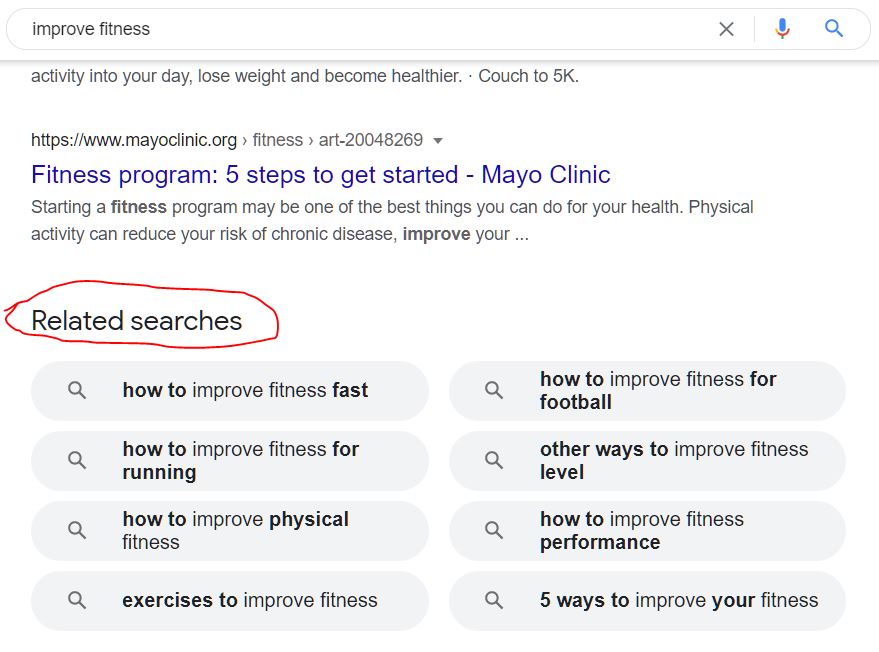
From here, come up with a list of potential business ideas.
Match them against the following:
- Are they focused on education and expertise?
- Is there a potential to scale them based on the IN/UP/MAX model?
- Are they Mission based, Passion based, or Opportunity based?
- Would this suit your Personality? Is it aligned to who you are as a brand?
- Can you see yourself doing this in the next five years?
#2 Testing Your Business Idea
The next phase involves testing your business ideas with various Google tests. Here’s where a bit of Search Engine Optimization (SEO) work comes into play.
a) Come Up with Your Bullseye Keyword
This is a short phrase (one to three words) that expresses “the process or journey or transformation that people will experience as a result of buying your product.”
Here’s how to do so:
- Come up with a one to three-word phrase based on your business idea above (eg “improve fitness”)
- Key it into Google to do the first test. See what comes out, and whether they are the right items.
- If they are the wrong items, change your keyword phrases until you find the right items coming up.
- Do the same for Amazon, Lazada, or other eCommerce stores where your product may be found.
b) Determine Market Size Sweet Spot
Do a couple of tests on Google Trends (Worldwide) to determine the stability of your business based on the past five years. Choose those that are more stable, like “orchid care.”

And not something that is trending downwards like “atkins diet.” Or highly erratic like “bitcoin mining.”
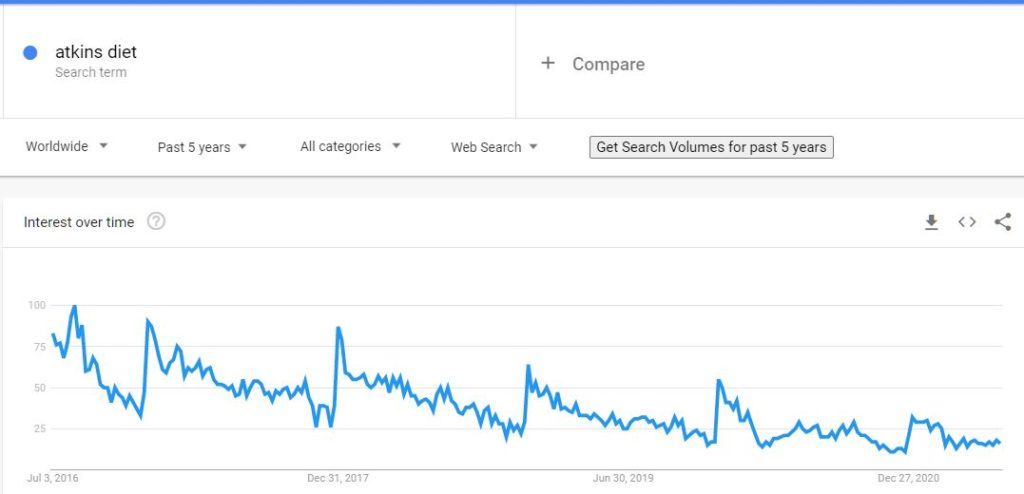

The Rosetta Stone Keywords
These are four magical keywords (“orchid care,” “improve memory,” “leadership skills,” “beekeeping”) that you can type into Google Trends to compare your desired keyword. If it lands within this range, it would fall into the Market Size Sweet Spot Range.
Apparently, the volume of searches for these keywords also represent a good size for the market — too high and competition may be too keen, too low and you may not have enough consumer interest.
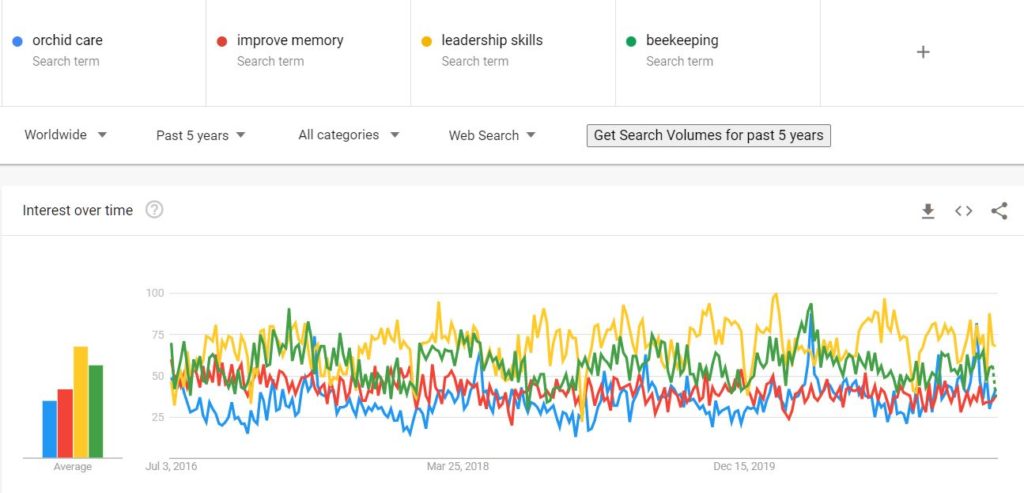
Let us try “dog training” to see how it compares. Whoa! It looks like it could be too large.
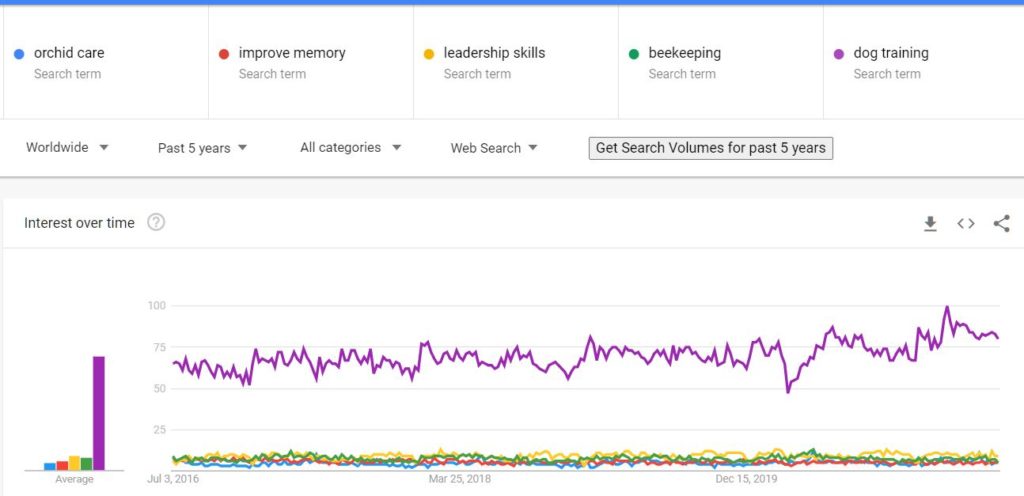
What if we change this to “start preschool” since that could be an opportunity. Hey it looks like it fits into the sacred four!
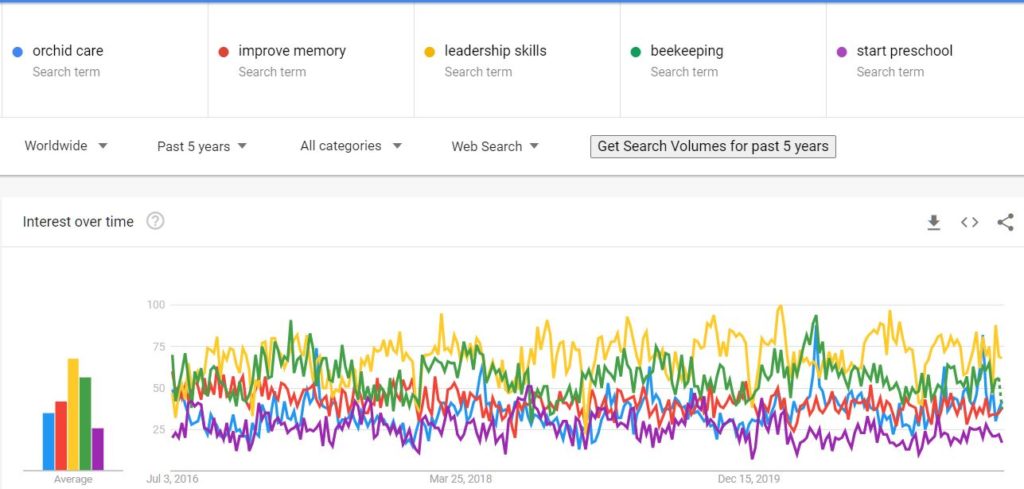
Do note that this could be based on the experience in the US, and your results may vary depending on which part of the world you come from.
c) Determine Market Competition Sweet Spot
Next, you’ll need to decide if your proposed business idea is too competitive, or whether there is a market for it at all.
To determine your market competition sweet spot, see whether your competitors are advertising on Amazon (or other eCommerce platforms). Determine specifically if they are also selling education and expertise products just like you’d be. This could be books, resource guides, e-Books etc.
The magic number here is about 3 to 7 advertisers for your product category. Here’s an example for Amazon.sg for “toys for kids 8 to 10” which has about 6 advertisements as shown:

If there are 1 to 2 ads, or 8 to 9 ads, it’ll be considered as less attractive (less interest, and more competition). If there are zero advertisers, or 10 or more, then the category could be too unattractive or too competitive.
d) Five Must-Haves of Every Market
In this final test, you’ll need to run through your idea against the following five criteria:
- Evergreen Market: Is it stable and non-cyclical? Beware of fad markets or those driven by technology trends
- Enthusiast Market: Can you find people enthusiastic about that specific topic? For example, people are more keen on playing guitar than on killing cockroaches!
- A $10,000 Problem: This would be an urgent, nagging, possibly life destroying or business killing problem in the context of that evergreen and enthusiast market. It is also where the MAX part of the IN/UP/MAX in your business model comes in.
- Future Problems: Do you see scope for future potential problems in the same market for the same customer that requires your help? This ensures sustainability and longevity.
- Players with Money: Oh boy this is so fundamental yet many people are oblivious to this point!
#3 Choosing and Launching Your Business
This final phase is really just to choose your business and “let it go” so to speak.
a) Choosing to Launch
Consider asking yourself these questions prior to “green lighting” your project:
- What do you want your business to be?
- Why is that important?
- What are you really after?
- What are you going to do when you get there?
b) Applying the Ask Method
After you’ve launched, you’d have knocked out both your market and your business model.
The next step is to focus on your message. To do so, Levesque proposes that you ask the Single Most Important Question:
“When it comes to _____ (your Bullseye Keyword), what’s the single biggest challenge, frustration, or question you’ve been struggling with? (Please be as detailed and specific as possible.)”
Also known as the ASK Method (which is his other bestselling book), it can be done through a survey link, a Facebook/Instagram/LinkedIn post, or any other method.
From there, you can identify any common themes, and use that to segregate your prospects into segments. You may then ask further questions to probe what they need and percolate down your list of services.
(We’ve done some variation of that in our contact form here.)
If you’re interested to know more about the ASK Method, you can try getting a free copy here (you pay shipping and handling).
Conclusion
From choosing your potential market, business model, and business idea, to validating it with a battery of tests, Choose provides a comprehensive step-by-step guide to wannabe entrepreneurs anywhere.
Personally, I found the process pretty useful although some of the tests like “market size sweet spot” may work differently for us here in Singapore vis-a-vis other markets.
You should probably also mix and match these tests against other “How To Choose a Business” techniques proposed by entrepreneur savants like Pat Flynn, Eric Ries, and Chris Guillebeau.
What’s your biggest challenge in starting your own business? Share it with me in the comments below!
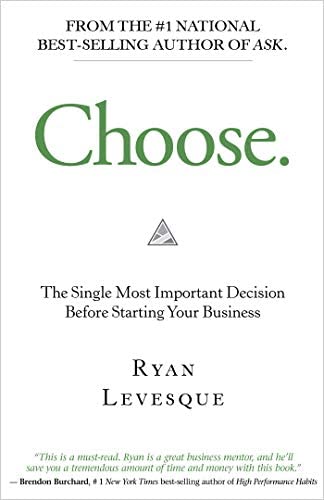

This article helped me start a new business. I appreciate your effort to publish this great article.
So much valuable information. I can guess the same this can be applied to finding a blogging niche and also do you think blogging is a profitable business…